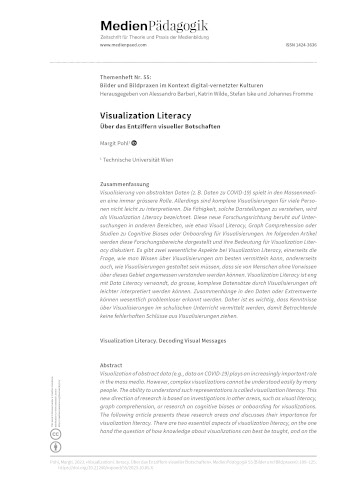Abstract
Visualization of abstract data (e.g., data on COVID-19) plays an increasingly important role in the mass media. However, complex visualizations cannot be understood easily by many people. The ability to understand such representations is called visualization literacy. This new direction of research is based on investigations in other areas, such as visual literacy, graph comprehension, or research on cognitive biases or onboarding for visualizations. The following article presents these research areas and discusses their importance for visualization literacy. There are two essential aspects of visualization literacy, on the one hand the question of how knowledge about visualizations can best be taught, and on the other hand how visualizations must be designed so that they can be understood by people who have no prior knowledge of this area. Visualization literacy is closely related to data literacy, as large, complex data sets can often be made easier to understand through visualizations. Relationships in the data or extreme values can be recognized much more easily. It is therefore important that knowledge about visualizations is taught in school so that viewers do not draw incorrect conclusions from the visualizations.
References
Alper, Basak, Nathalie Henry Riche, Fanny Chevalier, Jeremy Boy, und Metin Sezgin. 2017. «Visualization Literacy at Elementary School». In Proceedings of the 2017 CHI Conference on Human Factors in Computing Systems, 5485–97. Denver Colorado USA: ACM. https://doi.org/10.1145/3025453.3025877.
Börner, Katy, Andreas Bueckle, und Michael Ginda. 2019. «Data Visualization Literacy: Definitions, Conceptual Frameworks, Exercises, and Assessments». Proceedings of the National Academy of Sciences 116 (6): 1857–64. https://doi.org/10.1073/pnas.1807180116.
Börner, Katy, Adam Maltese, Russell Nelson Balliet, und Joe Heimlich. 2016. «Investigating Aspects of Data Visualization Literacy Using 20 Information Visualizations and 273 Science Museum Visitors». Information Visualization 15 (3): 198–213. https://doi.org/10.1177/1473871615594652.
Boy, Jeremy, Ronald A. Rensink, Enrico Bertini, und Jean-Daniel Fekete. 2014. «A Principled Way of Assessing Visualization Literacy». IEEE Transactions on Visualization and Computer Graphics 20 (12): 1963–72. https://doi.org/10.1109/TVCG.2014.2346984.
Dimara, Evanthia, Steven Franconeri, Catherine Plaisant, Anastasia Bezerianos, und Pierre Dragicevic. 2020. «A Task-Based Taxonomy of Cognitive Biases for Information Visualization». IEEE Transactions on Visualization and Computer Graphics 26 (2): 1413–32. https://doi.org/10.1109/TVCG.2018.2872577.
Ellis, Geoffrey. 2018. Cognitive biases in visualizations. Springer. https://doi.org/10.1007/978-3-319-95831-6.
Evans, Jonathan St BT. 2007. Hypothetical thinking: Dual processes in reasoning and judgement. Psychology Press.
Fiedler, Klaus, und Momme von Sydow. 2015. «Heuristics and biases: Beyond Tversky and Kahneman›s (1974) judgement under uncertainty». In Cognitive psychology: Revisiting the classical studies, 146-161. Sage: London, Thousand Oaks, California, New Delhi, Singapore.
Firat, Elif E, Alark Joshi, und Robert S. Laramee. 2022. «Interactive Visualization Literacy: The State-of-the-Art». Information Visualization 21 (3): 285–310. https://doi.org/10.1177/14738716221081831.
Friel, Susan N., Frances R. Curcio, und George W. Bright. 2001. «Making Sense of Graphs: Critical Factors Influencing Comprehension and Instructional Implications». Journal for Research in Mathematics Education 32 (2): 124–58. https://doi.org/10.2307/749671.
Gigerenzer, Gerd. 2015. Bauchentscheidungen: die Intelligenz des Unbewussten und die Macht der Intuition. C. Bertelsmann.
Hug, Theo. 2007. Didactics of microlearning. Waxmann.
Kahneman, Daniel. 2012. Schnelles Denken, langsames Denken. München: Siedler.
Kosslyn, Stephen M. 2006. Graph design for the eye and mind. OUP USA.
Lee, Sukwon, Sung-Hee Kim, und Bum Chul Kwon. 2017. «VLAT: Development of a Visualization Literacy Assessment Test». IEEE Transactions on Visualization and Computer Graphics 23 (1): 551–60. https://doi.org/10.1109/TVCG.2016.2598920.
Lo, Leo Yu-Ho, Ayush Gupta, Kento Shigyo, Aoyu Wu, Enrico Bertini, und Huamin Qu. 2022. «Misinformed by Visualization: What Do We Learn From Misinformative Visualizations?» Computer Graphics Forum 41 (3): 515–25. https://doi.org/10.1111/cgf.14559.
Malik, Shoaib Ahmed. 2017. «Revisiting and Re-Representing Scaffolding: The Two Gradient Model». Herausgegeben von Alexander W. Wiseman. Cogent Education 4 (1): 1331533. https://doi.org/10.1080/2331186X.2017.1331533.
Messaris, Paul. 1994. Visual ‹Literacy› – Image, Mind, and Reality. Boulder, San Francisco: Oxford: Westview Press.
Moore, David Mike. 1994. Visual literacy: A spectrum of visual learning. Educational Technology. Englewood Cliffs, New Jersey: Educational Technology Publications.
Norman, Geoff. 2014. «The bias in researching cognitive bias». Advances in Health Sciences Education. Wien/NewYork: Springer. https://doi.org/10.1007/s10459-014-9517-5.
Pohl, Margit. 2018. «Cognitive biases in visual analytics—A critical reflection». In Cognitive Biases in Visualizations, 177–84. Springer. https://doi.org/10.1109/JISIC.2014.68.
Roberts, Jonathan C., Panagiotis D. Ritsos, James R. Jackson, und Christopher Headleand. 2018. «The Explanatory Visualization Framework: An Active Learning Framework for Teaching Creative Computing Using Explanatory Visualizations». IEEE Transactions on Visualization and Computer Graphics 24 (1): 791–801. https://doi.org/10.1109/TVCG.2017.2745878.
Shah, Priti, Eric G Freedman, und Ioanna Vekiri. 2005. The Comprehension of Quantitative Information in Graphical Displays. Cambridge University Press.
Stoiber, Christina, Conny Walchshofer, Florian Grassinger, Holger Stitz, Marc Streit, und Wolfgang Aigner. 2021. «Design and comparative evaluation of visualization onboarding methods». In The 14th International Symposium on Visual Information Communication and Interaction, 1–5.
Stoiber, Christina, Conny Walchshofer, Margit Pohl, Benjamin Potzmann, Florian Grassinger, Holger Stitz, Marc Streit, und Wolfgang Aigner. 2022. «Comparative Evaluations of Visualization Onboarding Methods». Visual Informatics, Juli, S2468502X2200064X. https://doi.org/10.1016/j.visinf.2022.07.001.
Woll, Stanley. 2001. Everyday thinking: Memory, reasoning, and judgment in the real world. Psychology Press.

